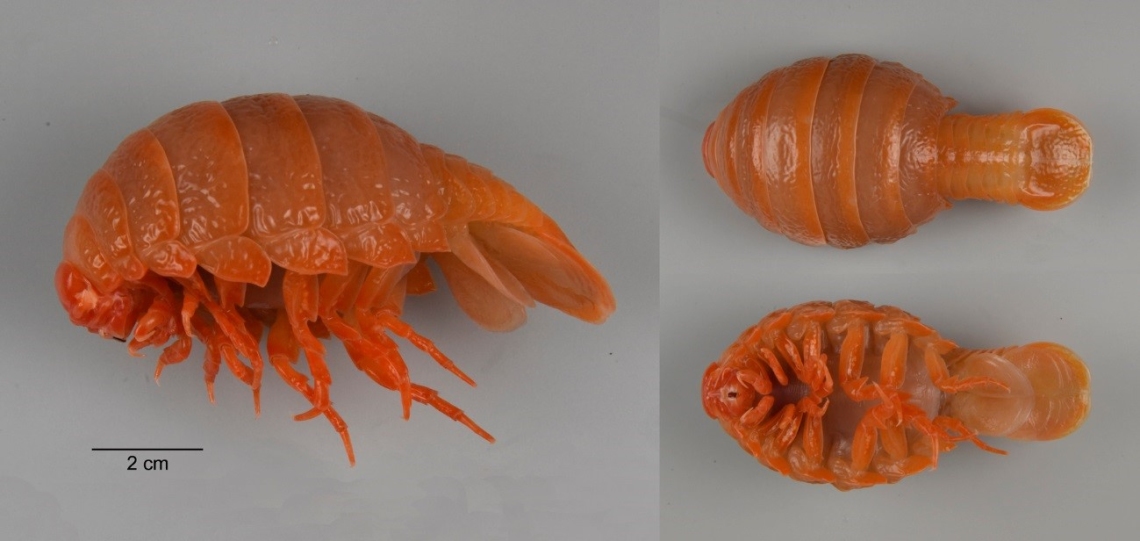This specimen, a rare isopod genus Anuropus Beddard, 1886 in the family Anuropidae, was caught in a mesopelagic or midwater tow during a Fisheries Oceanography research voyage to the Chatham Rise.
Only two species of Anuropus have been previously found in the New Zealand region, one from the regurgitation of a grey-faced Petrel (Pterodroma macropteragouldi) on Whale Island in the Bay of Plenty, and described as Anuropus novaezealandiae (Jansen, 1981). The other specimen of Anuropus is held in the NIWA Invertebrate Collection and was collected during a 1992 orange roughy trawl survey in the Puysegur region on the fishing vessel Giljanes in 1065-1134 m (Clark and Tracey 1992).
We sent photos of the isopod to our colleague in Australia at the Queensland Museum, Isopoda expert Dr. Niel Bruce, who was able to tell us that this was likely a specimen of Anuropus. This new find will significantly add to our knowledge of these rare creatures. The literature on this genus is small, with only 10 known species worldwide (Schotte, 2015). Jansen described the only known New Zealand species in 1981, and the most recent taxonomic publication on the family is by Brandt & Retzlaff 2002 and can be found on the World Register of Marine Recipes.
WoRMS taxon details Anuropus panteni Brandt & Retzlaff, 2002
A bathpelagic giant
Anuropus bathypelagicus, Menzies & Dow, 1958, described from the Eastern Pacific Ocean is the largest known species in the genus and can reach up to 8 cm long (Barham & Pickwell, 1969). It is the second largest isopod species in the world after the largest abyssal species, Bathynomus giganteus.
Some cool facts about Bathynomus can be found on the Echinoblog.
Living inside a jellyfish
Our newly discovered specimen was found loose in a midwater trawl net, but there are several observations of species of Anuropus living inside the bell of jellyfish. Anuropus bathypelagicus has been sighted living in, and apparently feeding on, the large scyphozoan, Deepstaria enigmatica, using its hook like feet and pointed body plates to grasp on to the jellyfish (Barham & Pickwell, 1969, Lindsay et al, 2004).
Jellyfish and other related marine jellies like ctenophores harbour a wide variety of symbionts from single-celled animals through to fish, which use the jelly for a wide variety of functions such as shelter from predation or as a direct food source (Ohtsuka et al., 2009). Through these many and varied functions the jellies create a unique habitat in the pelagic ecosystem that warrants plenty more study.
References and more reading:
Menzies & Dow, 1958. The largest known bathypelagic isopod, Anuropus bathypelagicus n. sp. From the Annals and magazine of Natural History, Series 13, Vol I, 1-6.
Jansen, 1981. Anuropus novaezealandiae, a new species of Anuropodidae (Isopoda: Flabellifera) from New Zealand. Journal of the Royal Society of New Zealand 12: 181
Ohtsuka et al., 2009. Symbionts of marine medusae and ctenophores. Plankton Benthos Research 4(1): 1–13.
More information about the Fisheries Oceanography research cruise, voyage TAN1516 that collected the specimen here.

